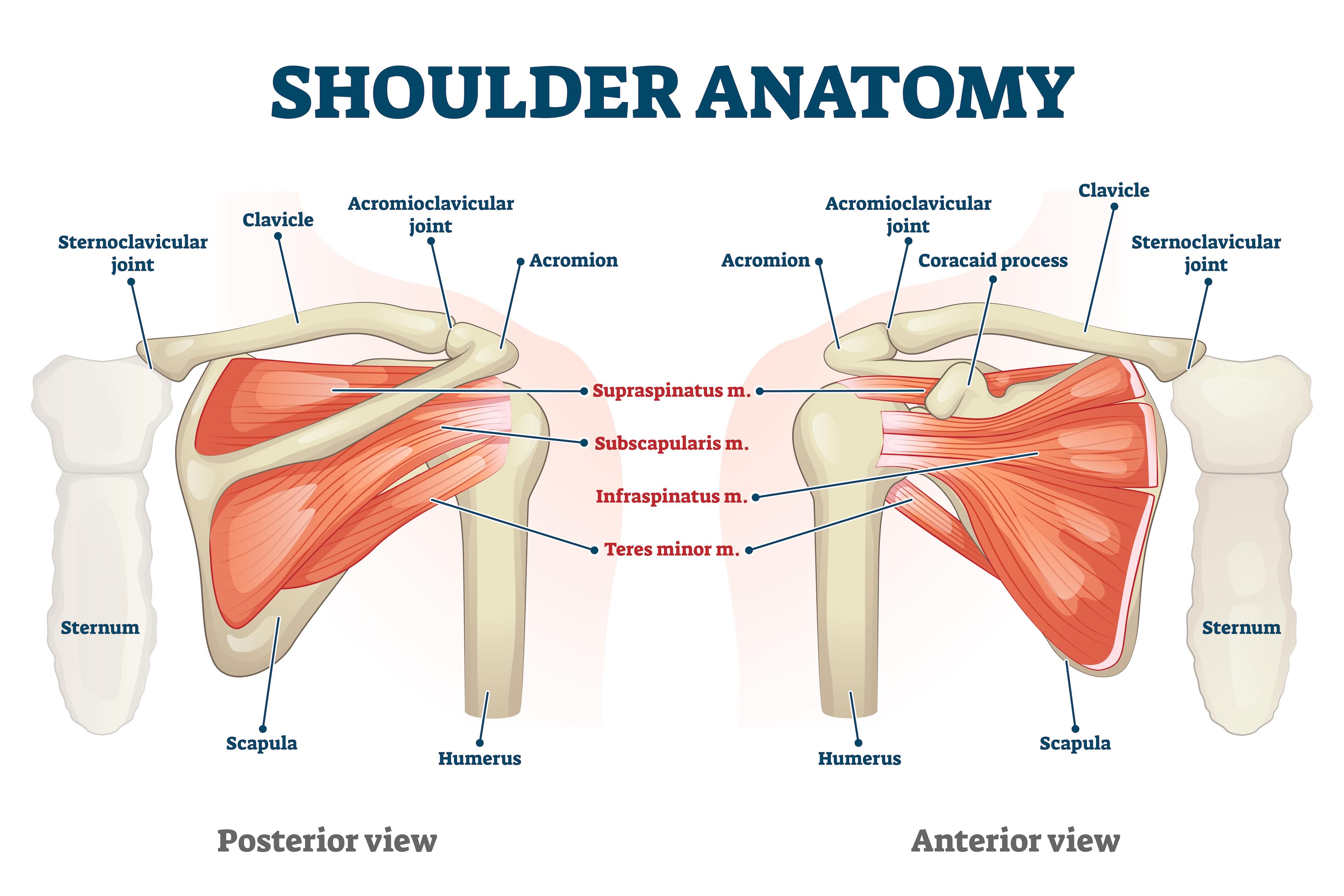Did you know that shoulder injuries are among the most common musculoskeletal problems people face? The shoulder is a complex and highly mobile joint, allowing us to perform a wide range of movements. However, this mobility comes at a cost, making it more susceptible to injury. By understanding the shoulder’s anatomy and common injuries, you can effectively manage pain, recover from injuries, and prevent further complications.
In this blog post, we will explore the intricacies of shoulder anatomy, common shoulder injuries, and their causes, diagnostic approaches, treatment options, and preventative measures.
Key Takeaways
- Understand shoulder anatomy and identify common injuries to diagnose and treat them promptly.
- Non-surgical therapies such as rest, physical therapy, pain management techniques can help with recovery.
- Preventing future injury requires proper stretching and strengthening exercises for maintenance of shoulder health.
Understanding Shoulder Anatomy
The shoulder joint is a remarkable structure that facilitates a broad spectrum of movements. The upper arm is composed of three bones – the humerus, scapula, and clavicle. These bones are connected and supported by various soft tissues, including muscles, tendons, and ligaments.

One of the key components of the shoulder joint is the rotator cuff, which is responsible for keeping the shoulder stable and allowing various arm movements. The rotator cuff consists of four muscles and their respective tendons, which attach to the humerus (upper arm bone).
The joint capsule is another significant structure, connecting the humerus to the shoulder socket on the scapula and providing stability to prevent dislocation.
Identifying Common Shoulder Injuries
Shoulder injuries can range from mild to severe, with the most common types being rotator cuff tears, dislocation and instability, and adhesive capsulitis (frozen shoulder). The shoulder’s flexibility and lack of stability make it more prone to injury. Timely identification of these injuries’ symptoms and seeking early medical attention is fundamental for accurate diagnosis and treatment.
Each of these common shoulder injuries will be discussed in detail in the subsequent sections.
Rotator Cuff Injuries
Rotator cuff injuries, such as a torn rotator cuff, are common among athletes and middle-aged individuals and can result from progressive deterioration of the rotator cuff tendon tissue, recurrent overhead activity, shoulder trauma, or extended wear and tear. Symptoms associated with a rotator cuff injury include a dull ache in the shoulder, difficulty combing hair or reaching behind the back, disturbed sleep, pain, weakness, and difficulty raising, lowering, or rotating the arm.
Diagnosing a rotator cuff injury typically involves a combination of patient history, physical examination, and imaging tests, such as MRI scanning. Treatment for a rotator cuff tear typically includes rest, ice, compression, elevation, and physical therapy. These conservative treatments can often alleviate pain and promote healing, allowing patients to regain function in their shoulder. However, in some cases, surgery for rotator cuff repair is required.
Dislocation and Instability
Shoulder dislocation occurs when the ligaments that secure the shoulder bones are ruptured, causing the joint to become unstable. Shoulder instability, on the other hand, occurs when the ligaments holding the joint in place become excessively stretched. Athletes, in particular, may experience shoulder instability as a result of certain motions used in tackling and pitching, which can put considerable force on the shoulder and stretch the ligaments over time.
A shoulder dislocation can be caused by a fall onto an outstretched hand, arm, or shoulder, or from a forceful twisting motion. The primary symptom associated with a dislocated shoulder is pain in the shoulder. Depending on the severity of the injury, treatment for shoulder dislocation and instability can range from icing the area, immobilizing the arm with a sling, engaging in physical therapy exercises, to undergoing surgery.
Adhesive Capsulitis (Frozen Shoulder)
Adhesive capsulitis, commonly referred to as frozen shoulder, is a condition characterized by:
- Stiffness and pain in the shoulder joint
- Restricted movement
- Difficulty moving the shoulder without experiencing pain and stiffness
- Worsening of the pain at night
These are the typical symptoms of frozen shoulder.
Frozen shoulder can be diagnosed through physical examination, range of motion tests, and imaging studies, such as noncontrast magnetic resonance imaging (MRI) or plain radiography. The primary causes of frozen shoulder are believed to be inflammation of the shoulder joint, alteration of the structures that support the shoulder, and autoimmune or endocrine disorders related to musculoskeletal and skin diseases.
Common treatments for frozen shoulder include oral medication, physical therapy, exercise, steroid injection, and PRP for optimal results.
Causes Behind Shoulder Pain
There are various factors that can lead to shoulder pain, including:
- Soft tissue injury
- Overuse
- Bone injuries · Degenerative diseases like osteoarthritis and rheumatoid arthritis
Generally, shoulder issues are due to soft tissue injury or illness, with frequent use from activities such as work, sports, and hobbies leading to soft tissue issues.
In addition to injury, degenerative conditions, and other diseases in the body, shoulder problems or pain that radiates to the shoulder area may be caused by:
- Arthritis
- Tendinitis
- Bursitis
- Rotator cuff tear
- Frozen shoulder
- Shoulder impingement
- Shoulder instability
Identifying the source of pain and seeking the right treatment is critical for managing shoulder pain and avoiding additional complications.
Diagnostic Approaches to Shoulder Injuries
Accurately diagnosing shoulder injuries is a significant step in deciding the suitable treatment course. A combination of diagnostic methods is typically used, including:
- Patient history
- Physical examination
- Range of motion tests
- Imaging tests such as X-rays, MRI, CT scans, EMG, ultrasound, and arthroscopy
- Laboratory tests
The location of pain within the shoulder, including the shoulder blade, can be a useful indicator for diagnosing the problem.
Imaging tests such as X-rays can be used to identify shoulder injuries such as fractures, dislocations, misalignments, and joint space narrowing. MRI, on the other hand, provides a non-invasive imaging technique that does not use radiation and can provide detailed images of the soft tissues, including the muscles, tendons, and ligaments in the shoulder. It can detect various shoulder conditions such as rotator cuff tears, labral tears, tendonitis, bursitis, and joint abnormalities.
Range of motion tests for the shoulder assess the joint’s movement and flexibility in various directions, indicating areas of restricted movement, pain, or discomfort to offer insights into shoulder injuries.
Treatment Options for Shoulder Recovery
Effective treatment of shoulder injuries is key to recovery and the prevention of long-term complications. There are two main categories of treatment options for shoulder injuries: non-surgical therapies and surgical interventions. Depending on the severity of the injury and the specific diagnosis, a combination of these treatments may be recommended to help patients regain pain-free mobility and strength in their shoulder.
Non-Surgical Therapies
Non-surgical treatments for shoulder injuries often include activity modification, rest, physical therapy, and pain management techniques. Activity modification involves refraining from or modifying activities that may further aggravate the injury, while rest facilitates the healing of injured tissues, minimizes strain on the shoulder joint, and reduces pain and inflammation.
Physical therapy plays a pivotal role in shoulder injury recovery. It encompasses treatment for shoulder conditions, including:
- Muscle stretching and strengthening
- Joint mobilization and stabilization
- Reduction of swelling and inflammation
- Restoration of movement and strength
Medications such as non-steroidal anti-inflammatory drugs (NSAIDs) and corticosteroids may be prescribed to provide relief from shoulder pain and aid in the recovery from injury.
Surgical Interventions
For some shoulder injuries, surgical interventions may be necessary. Available surgical options include:
- Rotator cuff repair
- Total shoulder replacement
- Arthroscopy
- Bankart repair
- SLAP lesion repair
- Shoulder arthroscopy
The specific surgical intervention recommended will depend on the severity of the injury and the patient’s individual circumstances.
Arthroscopy is employed for both the diagnosis and treatment of shoulder conditions, such as rotator cuff repairs, tendinitis, and other shoulder issues. Rotator cuff repair surgery involves reattaching the torn tendon to the humerus using an absorbable suture anchor.
Shoulder joint replacement surgery may be indicated in cases of osteoarthritis, rotator cuff tear arthropathy, avascular necrosis, and rheumatoid arthritis.
Prevention and Maintenance
Prevention of shoulder injuries and upkeep of shoulder health are key to sustaining an active lifestyle and sidestepping long-term complications. Proper stretching, strengthening exercises, and avoiding overuse can help keep your shoulders in top shape and reduce the risk of injury.
Exercises for shoulder injury prevention should include:
- Internal and external shoulder rotation
- Wall shoulder raises
- Standing or half-kneeling row/external rotation/press
- Bottom-up kettlebell press/static hold in half kneeling
- Scapular Y raise
- Scapular rows and shoulder extensions with a band
- Scapular retraction
By incorporating these exercises and strategies into your routine, you can protect your shoulders and enjoy a full range of motion without pain.
Summary
In conclusion, understanding the complex anatomy of the shoulder joint, recognizing common shoulder injuries, and knowing the available diagnostic approaches and treatment options are essential for effectively managing shoulder pain and preventing complications. By taking preventative measures and seeking appropriate treatment when needed, you can maintain healthy shoulders and continue to enjoy an active lifestyle without pain or limitations.
Frequently Asked Questions
Q. How can you tell if a shoulder injury is serious?
If you experience any of the above symptoms and are unable to perform normal movement with your shoulder, it is likely that the injury is serious. Swelling, pain at night, weakness or numbness in the arm or hand, or a visible abnormality of the joint should all be cause for concern.
Q. How do you know if shoulder pain is muscle or joint?
Joint pain is often felt when the body is at rest, while muscle pain is experienced when the body is in motion. Therefore, to differentiate between shoulder pain caused by a muscle or joint issue, it is important to pay attention to the type of pain experienced.
Q. What does a pulled muscle feel like in your shoulder blade?
Pulled muscle in shoulder blade can cause pain, weakness and limited range of motion in the affected arm.
Q. What are 2 warning signs of a rotator cuff tear?
Two warning signs of a rotator cuff tear are pain when moving the affected arm, and weakness or difficulty when trying to lift or rotate the arm.
Q. What are the most common types of shoulder injuries?
The most common shoulder injuries are rotator cuff injuries, dislocation and instability, and adhesive capsulitis (frozen shoulder).




